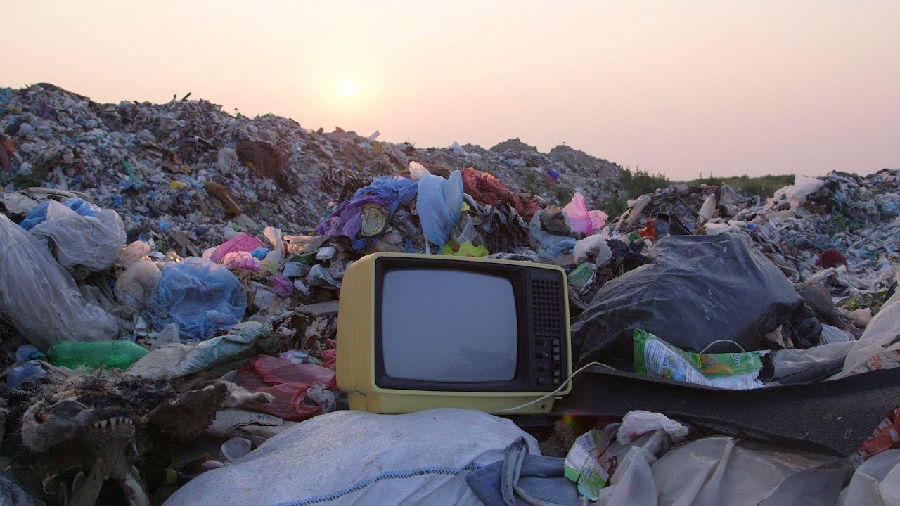这是一个垃圾掩埋场。
The world generates over a billion tons of garbage each year, that's a worth 3 million tons of garbage in a single day.
全世界每年要生产10亿多吨垃圾,相当于一天300万吨。
But a large majority of it doesn't even make it to a landfill, because it's chemically unstable.
然而,这些垃圾中绝大多数根本就没能进入垃圾掩埋场,因为他们的化学性质不稳定。
400 million tons of our yearly waste is considered hazardous, and has frequently burned up.
每年都有4亿吨的垃圾被认为是危险垃圾,其中很多都是要燃烧处理的。
The u.s. released eight hundred and eighty thousand tons of co2 emissions in 2016 alone.
仅2016年一年,美国就排放了88万吨的二氧化碳。
In fact a lot of the hazardous products that get sent to the incinerator, like aerosol cans, paint, and bleach, have barely been used.
然而,很多被送往焚烧炉的危险物品,如气溶胶,油漆,漂白剂,几乎都还没有开封。
If a product is dented or sticky, often a retailer can't or won't sell them, they just get thrown away.
产品有凹陷或变粘稠时,零售商通常就无法或者不再销售了。所以就被扔了。
And the disposal of these products can have a pretty disastrous effect on the environment.
然而,处理这些产品会对环境造成灾难性的影响。
So what are we doing to prevent this needless pollution?
那么,我们要怎样做才能防止这种不必要的污染呢?
Among household items,
家庭用品中,
substances are considered hazardous if they're toxic, corrosive, reactive, or flammable.
有毒、腐蚀性、会起反应或易燃的物品都被认为是危险品。
So pretty much anything you keep under the kitchen sink.
所以,大家放在厨房洗涤池下面的基本都属于这类产品了。
When a retailer or municipality needs to dispose of these materials,
零售商或市政当局需要处理这些东西时,
strict guidelines imposed by the EPA state that they can't just be thrown away in a landfill.
美国环保署的规定明确指出,不能将他们直接丢到掩埋场。
One reason for this is because landfills are outside, and susceptible to weather.
一方面是因为垃圾填埋场是露天的,容易受天气影响。
Rain snow or other precipitation can seep in, mix with or dissolve hazardous waste and become contaminated.
雨雪或其他降水可能会渗入,混入或溶解危险废物而被污染。
This contaminated water, called leachate, continues to seep into the earth, eventually making it into the water cycle.
这种被污染的水,也即渗滤液,继续渗入地下,最终就会进入水循环。
In an effort to prevent this, we send hazardous waste to an incinerator.
所以,为了预防这种情况,我们需要将危险废物送往焚化炉。
But that really isn't a great option either.
但焚化其实也不好。

Though incinerators are equipped with pollution control devices, pollutants from hazardous wastes can be difficult to remove.
尽管焚化炉配有污染控制装置,但危险废物中的污染物还是很难清除。
Molecules can still enter the air, and form new more harmful substances, and like leachate from landfills, find their way into the water cycle.
有害分子仍然可以进入空气,变成危害性更大的新物质,然后像垃圾填埋场的渗滤液一样进入水循环。
But what if we could prevent these materials from becoming waste in the first place?
然而,如果我们能够一开始就防止这些材料变成废物呢?
That's where the folks at Smarter Sorting come in.
“智能排序”那群人就是从这里看到了希望。
Smarter Sorting machine—— learning technology is creating the first smart chemical database that will empower chemical conservation around the world.
智能挑选机器学习的技术正在创造第一个智能化学成分数据库,从而推动世界各地的化学物品保护。
That's Chris Wrigley, CEO and founder of Smarter Sorting.
这位是Chris Wrigley,智慧分拣的首席执行官和创始人。
But what is it and how does it work?
但这个项目具体是怎么操作的呢?
What smart sorting does is it takes two high-resolution pictures of item, it weighs it, takes its barcode,
智能排序就是先给产品拍两张高清照片,然后称重,扫它上面的条形码,
and it assembles a complete data record of everything that's in the chemical.
然后将这个化学物品中的所有成分整理成一个完整的数据记录。
Which is pretty cool when you consider how broad the spectrum of hazardous materials really is.
考虑到有害物质的范围有多广时,他们的工作就显得非常酷了。
Remember those barely use dented or sticky containers,
还记得那些几乎没开封但有凹陷或变粘稠了的东西吗?
with this new information, disposal facilities and retailers can identify reusable products and divert them away from the incinerator.
有了这些新信息,废物处理站和零售商就能够分出可二次使用的产品,将其从焚烧炉中转移出去。
Perfectly good items that are still usable are sent to restore centers for second-hand purchase.
品质完好的产品就被送到回收中心进行二次销售。
Our vision is to do better things with orphan items.
我们的愿景就是用孤儿作品做更好的事情。
We're gonna help retailers and municipalities, put these items to use, for the purpose in which they were intended.
我们帮助零售商和市政当局把这些物品重新利用起来,发挥它们应有的作用。
And we're already seeing the results.
如今我们已经能看到成果了。
Tens of thousands of pounds of materials have been saved from incinerators thanks to smarter sorting.
由于更智能的分拣,焚烧炉节省了数万磅的材料。
That's great news.
这个消息实在是大快人心。
But as of now the world is still on pace to almost double its waste production by the year 2025.
但就现在来看,到2025年,全世界的垃圾产量差不多会翻一番。
That means we'll need to sort a lot more waste, and it starts with the products we bring home.
这就意味着,我们还需要分离出更多的垃圾,而行动应该从我们把产品带回家的那一刻开始。
So on your next grocery run, pick out the dented or sticky containers to put under your sink, so they don't just get thrown away.
所以,你下次买东西的时候,把那些有凹陷或有渗漏的瓶瓶罐罐都存在水槽下面,不要直接扔掉。
After all, the best way to prevent needless waste is to never let it become waste in the first place.
因为,不管怎么说,防止不必要的浪费,最好的方法就是永远不要让它成为废品。


